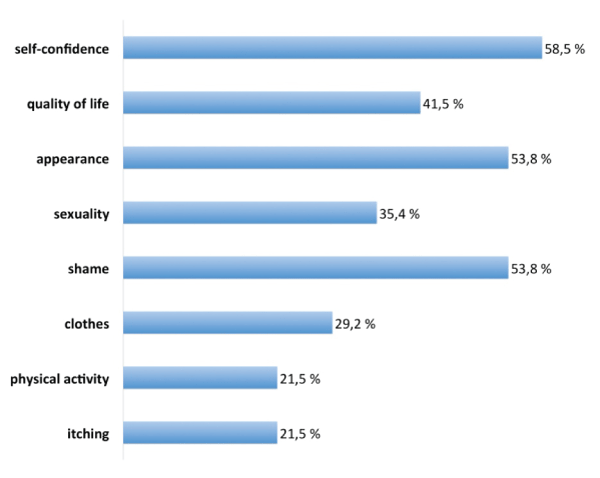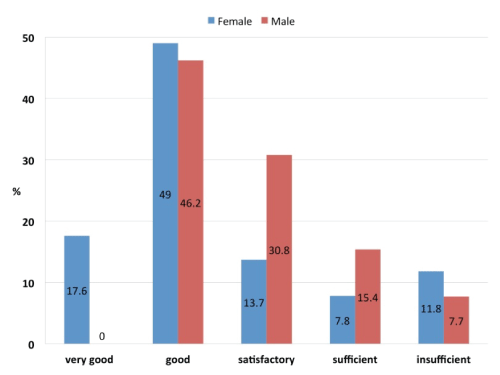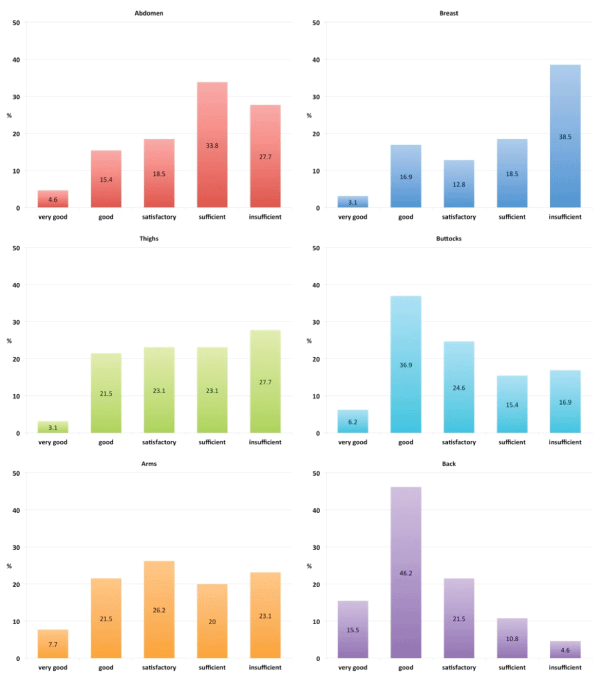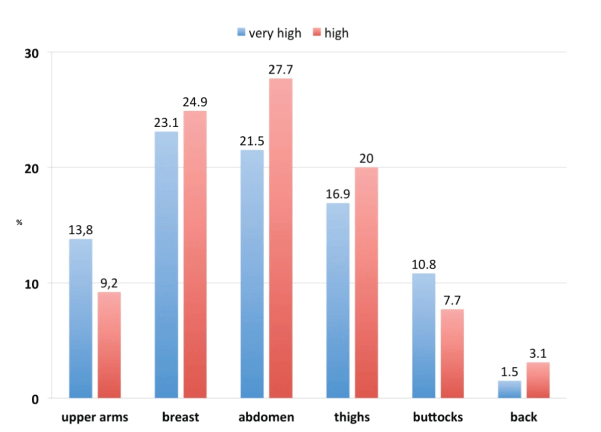Expectations from Body Contouring Surgery and Body-image Satisfaction in Post-Bariatric Patients
Robert Wenger1*, Mihai A. Constantinescu2, Hugo B. Kitzinger3 and Daniel M. Frey4
1Department of Surgery, Lucerne Cantonal Hospital, Switzerland
2Department of Plastic, Reconstructive and Hand Surgery, Bern University Hospital, Switzerland
3Division of Plastic and Reconstructive Surgery, Medical University of Vienna, General Hospital Vienna, Austria
4Department of Surgery, GZO Hospital Wetzikon, Switzerland
*Corresponding author:
Robert Wenger, Department of Surgery, Lucerne Cantonal Hospital, Lucerne, Switzerland, Spitalstrasse, 6000 Lucerne, Switzerland, E-mail: robert.wenger@gmx.at
J Obes Weight-Loss Medic,
JOWM-1-005, (Vol 1, Issue 1),
Research Article
Received: March 12, 2015: Accepted: July 02, 2015: Published: July 04, 2015
Citation: Wenger R, Constantinescu MA, Kitzinger HB, Frey DM (2015) Expectations from Body Contouring Surgery and Body-image Satisfaction in Post-Bariatric Patients. J Obes Weight-Loss Medic 1:005
Copyright: © 2015 Wenger R. This is an open-access article distributed under the terms of the Creative Commons Attribution License, which permits unrestricted use, distribution, and reproduction in any medium, provided the original author and source are credited.
Abstract
Introduction: Because of the important developments in bariatric surgery over the last decade there is a significant increase in patients with sequelae of post-bariatric massive weight loss, which include skin- and soft tissue redundancy. These body contour deformities can be improved using plastic- and reconstructive surgery techniques. It remains unclear what percentage of post bariatric patients will eventually undergo body contouring surgery and what their body image and expectations are. The current study evaluates body image satisfaction and expectations related to body contouring surgery in Swiss post-bariatric patients following their weight reduction.
Methods: Data was collected using a previously utilized questionnaire, which was mailed to all 113 patients who had undergone bariatric surgery in one Swiss bariatric center between November 2010 and July 2012.
Results: The return rate of the questionnaire was 57.7%. 73.8% of all patients desired body contouring surgery. 40% rated their desire for body contouring surgery as high or very high. Abdominal corrections were most requested, followed by corrections of breasts and thighs. The most important expectation from body contouring surgery was improved self-confidence (58.5%), followed by reduced feelings of embarrassment in public (53.8%) and improved appearance (53.8%).
Conclusion: The desire for body contouring surgery in Swiss post-bariatric patients is very high. Our data highlights the importance of including reconstructive post-bariatric surgery as a component of the multidisciplinary approach in the treatment of obesity.
Keywords
Body contouring surgery, Bariatric surgery, Post-bariatric, Massive weight loss
Introduction
Over the past few years the number of obese people increased continuously all over the world including Switzerland. The World Health Organization (WHO) defines overweight as a Body Mass Index (BMI) greater than or equal to 25, and obesity as a BMI greater than or equal to 30. With more than 1.4 billion overweight adults worldwide in 2008 obesity has nearly doubled since 1980. Of these over 200 million men and nearly 300 million women were obese [1] . According to the Sixth Swiss Nutrition Report 8.7% of men and 7.8% of women in Switzerland are obese and the number has continually increased in the last 30 years [2,3]. Obesity increases the risk of developing many serious chronic diseases like type 2 diabetes mellitus, high cholesterol levels or high blood pressure [4] and even increases the risk of premature death [5].
Over the last few years bariatric surgery has become a successful and popular method to decrease weight and thereby contributes to the reduction of the fore-mentioned diseases associated with obesity [6-8]. In addition, short-term follow-up studies have shown that bariatric surgery has a positive effect on the quality of life [9-11]. Due to this success the number of bariatric interventions has increased worldwide and their number raised in the United States from 16.200 in 1992 to 220.000 in 2009 [12]. Similarly, bariatric surgery has also become quite popular in Switzerland and bariatric centers have spread all over the country. Fifty three bariatric centers are currently accredited [13]. According to the Swiss Study Group for Morbid Obesity the number of bariatric procedures in Switzerland has increased from 703 procedures in 2001 to about 4000 procedures in 2013[14].
Along with the positive effects of massive weight loss the negative effect of developing excess skin is commonly observed. This skin- and tissue redundancy not only leads to mechanical strains but also to subsequent limitations in physical activities, hygienic problems and intertriginous dermatitis, and severe psychological problems [15,16]. As a result excess skin has a negative impact on quality of life and may therefore contribute to one of the long-term post-bariatric problems namely a weight regain observed approximately 18 months after bariatric surgery [17].
Modern plastic- and reconstructive surgery techniques allow the correction of body contour deformities following massive weight reduction. New data show that plastic surgery improves long-term weight control after bariatric intervention [18]. Therefore the number of body contouring surgery after massive weight loss increased in parallel to the increase of bariatric interventions over the last few years. According to The American Society of Plastic Surgeons more than 45.000 body contouring procedures after massive weight loss were performed in the United States in 2012 [19] and a similar increase can be expected in Switzerland.
The plastic surgeon must choose the appropriate surgical technique according to the individual body contour deformity and has to find the optimal time point for surgery in each individual case. There are different studies addressing desire and expectations towards body contouring surgery after massive weight loss in different countries [15,16,20,21], however, little information about the situation in Switzerland is available. The aim of the current study was to evaluate body image satisfaction, frequency of soft tissue and skin problems, as well as desire for and expectations from body contouring surgery in Swiss post-bariatric patients.
Material and Methods
A retrospective, single center study design was chosen. Between November 2010 and July 2012 a total number of 113 patients underwent bariatric surgery (either Sleeve-Gastrectomy or Roux-en-Y Gastric Bypass) in one Swiss bariatric center. 12.54 (+/- 5.5) months after bariatric surgery, the patients were sent by post a questionnaire. The reply was anonymous. All of the 113 consecutive bariatric patients were included in the study. There were no exclusion criteria.
The questionnaire was adapted from Kitzinger et al. [15,22] and included 33 items which can be divided into 3 sections: The first section concerned demographic aspects like age, sex, current family status, height, current weight and highest weight of the patients. The second section contained items addressing the bariatric procedure and the postoperative satisfaction about specific body parts. Moreover, experience following weight loss and difficulties associated with excess skin were addressed. Here the patients responded to the items using a 5-point Likert-scale ranging from "very good" to "insufficient" and a 3-point Likert-scale ranging from "never" to "recurring". The third section involved questions regarding the desire to undergo body contouring surgery using a 5-point Likert-scale from "very pronounced" to "not existent" and asked about the expectations from body contouring surgery. The entire questionnaire took 10 to 15 minutes to complete.
Statistical Analysis
Statistical analyses were performed using IBM SPSS version 21. Descriptive statistics are given as mean and standard deviation, as median and range, or as number and percentage. The Mann-Whitney U test was used to analyze differences between men and women. The Chi-Squared Test based on Pearson was used to analyze the differences between normal and overweight patients. Statistically significant differences were defined as a p value <0.05.
Results
Patient population
The response rate was 57.7% with 65 patients out of 113 patients returning the completed questionnaire. From this cohort 80% of the patients were female. The mean age was 47.2 (±11.86) years ranging from 19 to 75 years old. 61.5% of the participants were married and 35.4% were single. The mean follow-up after bariatric surgery was 12.54 (±5.5) months.
The BMI prior to the bariatric procedure ranged from 33.46kg/m2 to 69.14kg/m2 with a mean BMI of 42.43kg/m2 (±6.15). The mean BMI after bariatric surgery at the time of follow-up was 29.13kg/m2 (±5.40), ranging from 21.48kg/m2 to 49.22kg/m2 and the mean excess weight loss was 73.02% (±23.01). 39 patients (60%) underwent Roux-en-Y Gastric Bypass and 26 patients (40%) underwent Sleeve-Gastrectomy. 16 patients (24.6%) underwent another bariatric intervention already previously.
Prior to the bariatric surgery the majority of patients (83.1%) had been informed of the possibility of surplus skin after massive weight loss by a doctor and almost all (98.5%) expected surplus skin after bariatric surgery.
Body image satisfaction
The overall appearance following bariatric surgery on a 5-point Likert-scale, was rated by the patients as good by 47.7%, satisfactory by 16.9%, very good by 13.8%, insufficient by 10,8% and as sufficient by 9.2%.Although none of the male patients rated his appearance as very good (Figure 1), there was no statistically significant difference between male and female (p=0.146).
In contrast, the rating of the appearance of specific body parts on the same 5-point Likert-scale was less positive (Figure 2). Especially the appearance of the abdomen and breast was rated as unattractive, but also the appearance of the thighs was not appreciated by over 50% of the patients. Significantly more women rated their arms (p=0.035) and thighs (p=0.019) as aesthetically unsatisfactory when compared to males. No statistically significant differences were observed in the rating of buttocks, back, breast and abdomen (Table 1).
![]()
Table 1: Detailed appearance rating after bariatric surgery for women and men
View Table 1
Frequency of soft tissue and skin problems
Over sixty percent of patients (61.5%) never suffered from intertriginous dermatitis and itching, 20% occasionally and 15.4% frequently. When asked about problems in finding suitable clothes, 63.1%patients reported no difficulties, 30.8% occasionally and 6.2% reported to have difficulties most of the time. Furthermore 63.1% of the patients never had difficulties in performing sports because of surplus skin, 30.8% occasionally and 4.6% reported frequent difficulties.
Desire for body contouring surgery
Overall 78.5% of the patients knew about the surgical options to improve body contour deformities and 73.8% of the patients wished to undergo body contouring surgery at some stage. Dividing the patients into those who reached a normal weight (BMI < 25kg/m2 ) and those who were still overweight (BMI ≥ 25kg/m2 ) at the time of survey there was no statistically significance in desire for body contouring surgery (p=0.886) (Table 2).
![]()
Table 2: Request for body contouring surgery in different weight categories
View Table 2
A total of 76.9% patients wished to have more information about the possibilities of body contouring surgery. In the rating of the desire for body contouring surgery in general on a scale from 1 (very high) to 5 (not existent)36.9% of the patients judged their desire as average, 23.1% as very high, 16.9% as high, 12.3% as little and 10.8% as not existent. There was no statistically significant difference between male and female (p = 0.986). Specifying the same question for different parts of the body, the desire to improve body counter deformities was highest for the abdomen and the breast, followed by the thighs (Figure 3). This parallels the outcome of the satisfaction rates in the questionnaire.
Expectations towards body contouring surgery
The last part of the questionnaire concerned the beneficial expectations from plastic surgery. In this section, multiple answers were possible. The foremost expectation was the improvement of self-confidence, followed by improvement in appearance and the reduction of feeling ashamed in public (Figure 4).

.
Figure 4: Expected improvements by body contouring surgery (multiple answers possible)
View Figure 4
Discussion
Modern plastic body contouring surgery is currently the only intervention which can solve the problem of surplus skin and relieve the associated physical and psychological discomfort. In this single center study, 73.8% of Swiss post-bariatric responding patients desired body contouring surgery. This data is similar to the observations in other countries like Sweden 75% [16], Scotland 73,4% [20], Saudi Arabia 78.4% [21] and Austria 74% [22]. These facts presage that also in Switzerland an increasing number of massive weight loss patients will present for reconstructive body contouring surgery following bariatric intervention.
All in all 78.4% of the patients declared satisfaction with their overall experience after bariatric surgery (rating very good, good or satisfactory). Surprisingly, with no male patient rating his appearance as very good, men seem to consider their overall appearance less positive than women. This is in contrast to the study of Kitzinger et al. [15] and Biorserud et al. [23], where women rated their body image significantly more negative than men. Only 23.1% of the male and 19.6% of the women rated their appearance as sufficient or even insufficient. This observation suggests that Swiss post-bariatric patients are overall satisfied with the improvement of their body image as a whole. Patients though rated the outcome for individual parts of their body less favorable. 73.8% of the patients rated at least one body part as sufficient or insufficient. Especially the appearance of the abdomen (61.5% rated sufficient or insufficient) and breast (57% rated sufficient or insufficient) were rated negative. The same observation was reported in other studies, where the abdomen was the body part causing most discomfort [15,16,22,24]. Consequently, the desire for body contouring surgery in the area of the abdomen is highest, followed by breast and thighs. The apparent difference between the rating of general appearance and the judgment of specific parts of the body can be explained by the predominant relieve of loss of the obese appearance. With the detailed questionnaire the patients were asked specifically to inspect accurately parts of the body which is why disappointment may have risen.
Surprisingly, the discomfort caused by surplus skin was generally rated rather low. For example, 61.5% of the patients reported that they never had suffered from intertriginous dermatitis or itching and 63.1% of the patients did not feel hampered in physical activity. This data is in contrast to the findings by Staalesen et al. [16] were 63.9% of female and 40.2% of male patients reported itching and rashes, as well as 60.0% of female and 44.7% of male reported difficulties in doing sport. This suggests that in our cohort of patients, physical activity or itching is conceived as less important than appearance and social acceptance, whereas in Sweden individual symptoms may have a higher ranking.
An important question for plastic surgeon treating the patient is the expectation of the patients from body contouring surgery. In this survey, the majority of patients expect improvements in self-confidence and being less ashamed in public, whereas only a minority hoped for an improvement of physical activity. This data shows that the expectations towards body contouring surgery are focused on improving psychological strains than physical strains. Therefore it is an important task of plastic surgeons to inform patients comprehensively about the expected outcome of the intervention and outline realistic expectations. The data also suggest that even in the absence of physical strains disappointment about the still imperfect body contour arises. This finding suggests that the bariatric surgeons have to discuss realistic expectations with the patient prior to engaging in the first bariatric procedure.
One of the limitations of this study is the rather short follow-up period after the bariatric intervention. As a result some of the patients may not have reached the maximal weight loss yet and therefore have not yet made their final decision about acceptance or disappointment. This may also be reflected by the fact that only 57.7% of the patients responded to the questionnaire. Another limitation is the retrospective study design.
In addition, the cohort was rather small and is derived from a single bariatric center. This bariatric center represents an average urban community and we are convinced that it is representative for the urban Swiss-german society. It will be of importance that similar studies are undertaken by other bariatric centers reflecting areas and population with different traditional background and mentality such as Swiss rural, French or Italian speaking regions.
Conclusion
The present study indicates that the desire for body contouring surgery in Swiss post-bariatric patients is very high. Especially abdomen, breast and thighs are the body areas of high discomfort. In Switzerland there is to date no data available neither about the percentage of post-bariatric patients undergoing secondary body contouring procedures nor about their satisfaction with the outcome. This important question will be the topic of future studies. Nevertheless, our data highlights the importance of including reconstructive surgery as a component in the multidisciplinary approach in the treatment of obesity and indicate the need to develop national guidelines on post bariatric, reconstructive body contouring surgery.
Ethical Standards
The manuscript does not contain patient data. The study has been performed in accordance with the ethical standards set forth in the 1964 Declaration of Helsinki and its later amendments.
Acknowledgement
The Paper was presented at the 49th Annual Meeting of the Swiss Society of Plastic, Reconstructive an Aesthetic Surgery, 1-2 November 2013, Lugano, Switzerland.
Supplementary file
References
-
World Health Organization (2014) Obesity and overweight,
-
Sixth Swiss Nutrition Report - Summary (2012) Federal Office of Public Health FOPH.
-
Sechster Schweizerischer Ernährungsbericht (2012) Bundesamt für Gesundheit BAG.
-
Must A, Spadano J, Coakley EH, Field AE, Colditz G, et al. (1999) The disease burden associated with overweight and obesity. JAMA 282: 1523-1529.
-
Prospective Studies Collaboration, Whitlock G, Lewington S, Sherliker P, Clarke R, et al. (2009) Body-mass index and cause-specific mortality in 900 000 adults: collaborative analyses of 57 prospective studies. Lancet 373: 1083-1096.
-
Sjöström L, Narbro K, Sjöström CD, Karason K, Larsson B, et al. (2007) Effects of bariatric surgery on mortality in Swedish obese subjects. N Engl J Med 357: 741-752.
-
Buchwald H, Avidor Y, Braunwald E, Jensen MD, Pories W, et al. (2004) Bariatric surgery: a systematic review and meta-analysis. JAMA 292: 1724-1737.
-
Maggard MA, Shugarman LR, Suttorp M, Maglione M, Sugerman HJ, et al. (2005) Meta-analysis: surgical treatment of obesity. Ann Intern Med 142: 547-559.
-
Sarwer DB1, Wadden TA, Moore RH, Eisenberg MH, Raper SE, et al. (2010) Changes in quality of life and body image after gastric bypass surgery. Surg Obes Relat Dis 6: 608-614.
-
Kolotkin RL, Crosby RD, Gress RE, Hunt SC et al. (2009) Two-year changes in health-related quality of life in gastric bypass patients compared with severely obese controls. Surgery for obesity and related diseases : official journal of the American Society for Bariatric Surgery 5: 250-256.
-
Shiri S, Gurevich T, Feintuch U, Beglaibter N (2007) Positive psychological impact of bariatric surgery. Obes Surg 17: 663-668.
-
Elliot VS (2014) Bariatric surgery maintains, doesn't gain.
-
SMOB (2014) Liste der schweizerischen anerkannten bariatrischen Zentren.
-
Bauknecht F (2014) Bariatrische Operationen in der Schweiz 2001-2013.
-
Kitzinger HB, Abayev S, Pittermann A, Karle B, Bohdjalian A, et al. (2012) After massive weight loss: patients' expectations of body contouring surgery. Obes Surg 22: 544-548.
-
Staalesen T, Fagevik Olsén M, Elander A (2013) Experience of excess skin and desire for body contouring surgery in post-bariatric patients. Obes Surg 23: 1632-1644.
-
Sjöström L, Lindroos AK, Peltonen M, Torgerson J, Bouchard C, et al. (2004) Lifestyle, diabetes, and cardiovascular risk factors 10 years after bariatric surgery. N Engl J Med 351: 2683-2693.
-
Balagué N, Combescure C, Huber O, Pittet-Cuénod B, Modarressi A (2013) Plastic surgery improves long-term weight control after bariatric surgery. Plast Reconstr Surg 132: 826-833.
-
Body Contouring After Massive Weight Loss. 2012 Plastic Surgery Statistics Report.
-
Al-Hadithy N, Mennie J, Magos T, Stewart K (2013) Desire for post bariatric body contouring in South East Scotland. J Plast Reconstr Aesthet Surg 66: 87-94.
-
Aldaqal SM, Samargandi OA, El-Deek BS, Awan BA, Ashy AA, et al. (2012) Prevalence and desire for body contouring surgery in postbariatric patients in saudi arabia. N Am J Med Sci 4: 94-98.
-
Kitzinger HB, Abayev S, Pittermann A, Karle B, Kubiena H, et al. (2012) The prevalence of body contouring surgery after gastric bypass surgery. Obes Surg 22: 8-12.
-
Biörserud C, Olbers T, Fagevik Olsén M (2011) Patients' experience of surplus skin after laparoscopic gastric bypass. Obes Surg 21: 273-277.
-
Mitchell JE, Crosby RD, Ertelt TW, Marino JM, Sarwer DB, et al. (2008) The desire for body contouring surgery after bariatric surgery. Obes Surg 18: 1308-1312.








